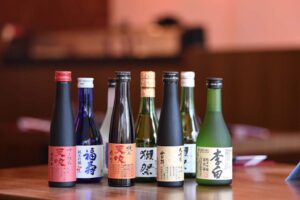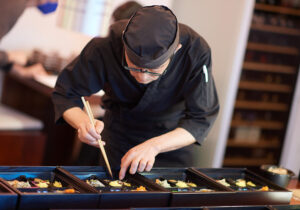The japanese cuisine, Sushi, Sashimi, Kaiseki, Bentō — all exciting buzzwords that have already found their way into everyday German usage and make the hearts of chefs and culinary enthusiasts beat faster. But not everything lives up to this hype—many restaurants advertise Japanese cuisine even though they don't offer Japanese flavors, and there are even culinary styles that want to borrow the glamour of Japanese cuisine but have nothing to do with it. Here are a few words about what we consider to be „Nanchatte“—well-intentioned, but not skillfully executed or legitimately labeled as Japanese cuisine.
Sushi without a proper base
The fact that rice is the most important ingredient in sushi is evident in the etymology of this well-known cuisine: because the characters for sushi mean „mildly fermented rice.“.
We are constantly asked where we get our fish from, with the implication that this is the most important aspect of sushi. But the most important thing about sushi is „“Everything!„ as Master Yagawa would say—and that starts with the rice. The right rice must be tasted and seasoned correctly so that the right flavor can be achieved in the end. A lot of knowledge about handling fish and cutting techniques and so on and so forth is also required. No wonder that a city like Munich is flooded with “fake sushi restaurants" that tend to spoil your appetite for good sushi. They like to flambé and cover with sauces what has not been done properly underneath, in the base, namely the fine balancing of rice, rice vinegar, manual processing of each individual sushi and, finally, all other ingredients such as fish, vegetables, nori, and wasabi. More on this elsewhere, but with sushi in particular, the wheat is separated from the chaff with every single plate.
Nikkei is not Japanese cuisine
Nikkei cuisine has been the talk of the town in recent years, including here in Munich. It looks like a modern, more colorful mix of Peruvian and Japanese cuisine. Raw fish, sashimi, high quality, sushi but with a modern twist, perhaps with a little more spiciness is the image that emerges. In advertising texts, one often reads that Nikkei has the high quality and perfection of Japanese cuisine, but adds the rich flavors of Peruvian cuisine.
Based on our experience, we find this assessment somewhat difficult to accept. After all, Japanese cuisine uses a variety of elaborate preparation techniques to bring out the subtle and deep flavors of its ingredients. It seems counterintuitive to put a lot of effort into a dish to create deep and subtle flavors and then pour a spicy sauce over it.
In our experience, the reality is that Nikkei cuisine usually only uses a reflection of Japanese cuisine, for example by using raw fish as a base ingredient or the buzzwords sashimi or sushi, but then instead of the elaborate Japanese process, it only adds an intense sauce or „ceviche.“.
Nikkei cuisine largely unknown in Japan
In fact, there is no Nikkei cuisine in Japan, and it is safe to say that hardly any Japanese in Japan know of its existence.
For chefs who follow the Japanese cooking method and use their skills to create modern Japanese cuisine, Nikkei is a cuisine from a completely different country to Japan.
Where the name Nikkei comes from
Nikkei is a kind of term for Japanese immigrants in South America and other countries. Their children and grandchildren, who knew nothing about life in Japan, had tried to serve Japanese-style dishes that they had learned from their parents or grandparents as a kind of Japanese cuisine.
The history of Nikkei begins with the arrival of Japanese immigrants in Peru, particularly since 1899. These immigrants were looking for new opportunities and began to engage in agriculture and later in fishing. Over time, they introduced Japanese cooking techniques, but adapted them to the ingredients that were available in their new homeland.
Japanese expat cuisine in Peru
However, it was very difficult to prepare a dish similar to Japanese cuisine with the ingredients available in South America when logistics were not as developed as they are today. And not every emigrant from Japan was a highly trained Japanese chef: Japanese emigration to South America and Hawaii did not have a good image for many Japanese. This is because many of the immigrants came from very poor backgrounds in Japan, and many of them emigrated because they were economically bankrupt and looking for a way out. And indeed In the view of some Japanese, the descendants of such emigrants, when they return to Japan, are often regarded as difficult people who do not really find their way in Japanese society. Japanese society is known to be extremely rigid, so we are not surprised that some people fall through the cracks in Japan.
Conclusion: Nikkei actually has nothing to do with Washoku
A Japanese origin does not automatically mean that a person can also cook Japanese food - and Nikkei cuisine usually means that the food has nothing to do with Japanese cuisine at all.
Precisely what characterizes Nikkei - the spicy South American flavors, the arrangement of the dishes with "flowers" in different colors (the opposite of the minimalist Japanese Moritsuke), the bright colors and intense, often spicy flavors - stands in clear contrast to Japanese cuisine.
In Japan itself, Nikkei cuisine is not as widespread as in countries such as Peru or on the global gastronomic scene. This is partly because Japanese cuisine, known as washoku, has a deep cultural and historical significance in Japan and is prized for its purity and tradition. Japanese society holds its culinary traditions in high esteem and preserves them with great care. Although the Japanese often view things from abroad with great curiosity and embrace them with enthusiasm, Nikkei cuisine is more akin to an emigrant who has not made it in Japanese society and is now returning without the proper "manners".
Of course, Nikkei can still be a delicious, exciting, and high-quality gastronomic experience, as is the case at Nikkei Kitchen in Munich, for example. As long as you are aware that Nikkei actually has nothing to do with Washoku, sushi, or sashimi in the Japanese style, it's all legitimate. However, you should be wary when modern, very expensive restaurants describe themselves as „Japanese with a Nikkei influence,“ because in most cases, no actual Japanese work is being done, sushi is not made according to Sushi tastes good and Sashimi is not real sashimi, but simply nanchatte.


